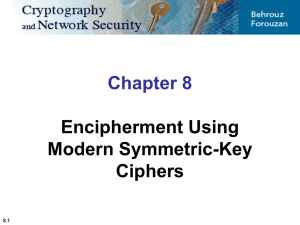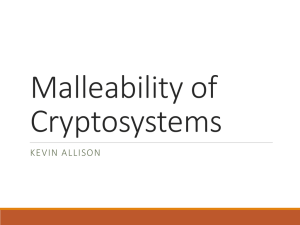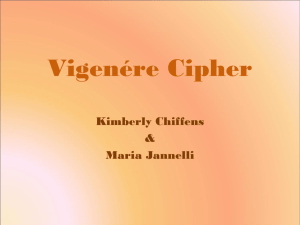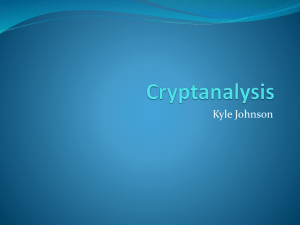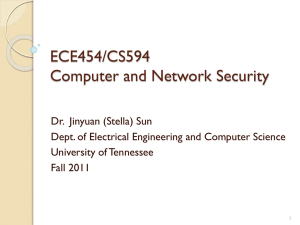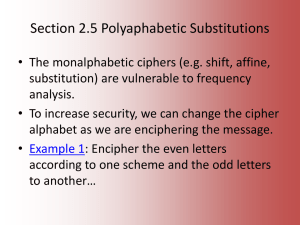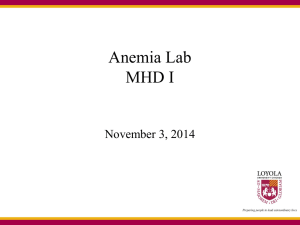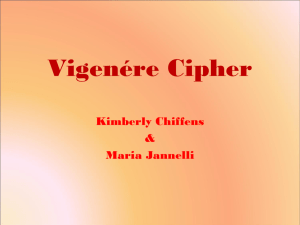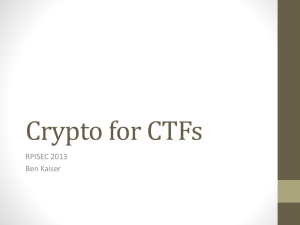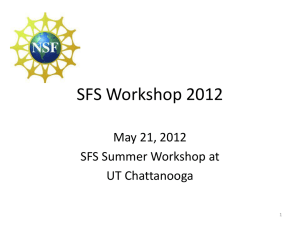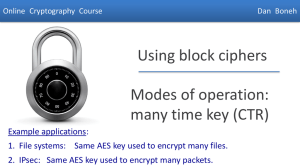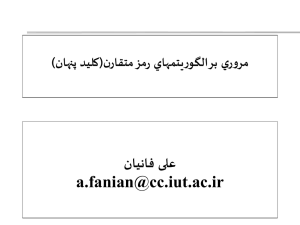Lec4
advertisement
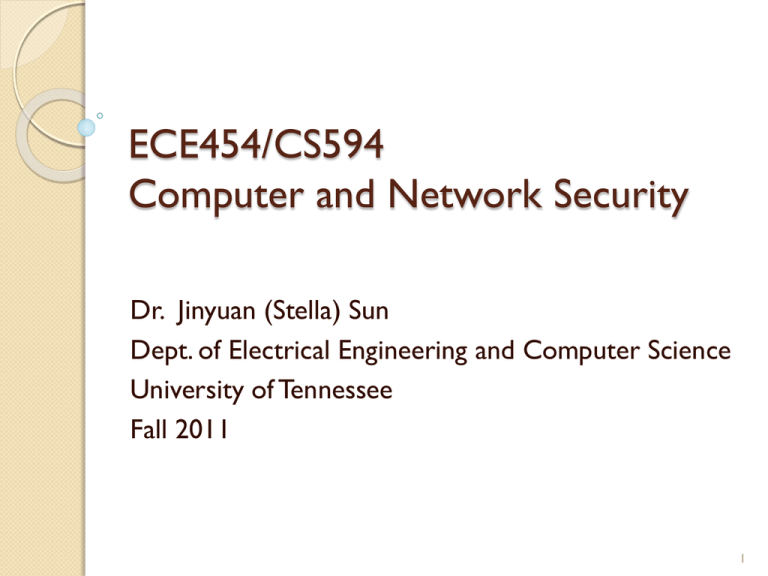
ECE454/CS594
Computer and Network Security
Dr. Jinyuan (Stella) Sun
Dept. of Electrical Engineering and Computer Science
University of Tennessee
Fall 2011
1
Secret Key Cryptography
•
•
Modes of operation
Stream cipher
2
Encrypting A Large Message
How to encrypt a message > 64 bits?
Electronic Code Book (ECB)
• Cipher Block Chaining (CBC)
• Output Feedback Mode (OFB)
• Cipher Feedback Mode (CFB)
• Counter Mode (CTR)
•
3
ECB Mode
ECB Encryption
ECB Decryption
•
Message is broken into 64-bit blocks
•
Each block is independently encoded with the same secret key
4
Pros and Cons of ECB
• Suitable for use in secure transmission of single values
(e.g. an encryption key)
• Error in one received ciphertext block does not affect the
correct decryption of other ciphertext blocks
• Identical plaintext blocks produce identical ciphertext
blocks resulting in recognizable pattern
•
Ciphertext blocks can be easily rearranged or modified
5
ECB Rearranging and
Modification Attacks
10,000’s digit of salary easily modified
• 10,000’s digit blocks easily swapped
•
6
CBC Mode
CBC Encryption
CBC Decryption
•
•
Selects a random number: IV (initialization vector) that is
XORed with the first plaintext block. Why?
Then generates its own random numbers: the ciphertext from
the previous block, XORed with the next plaintext block
7
Pros and Cons of CBC
Suitable for use in general-purpose block-oriented
transmission, and authentication
•
• The
same block repeating in the plaintext will not cause
repeats in the ciphertext
• Subject to modification attack: (but error propagates)
Subject to ciphertext block rearranging attack
• IV: needs to be shared between sender and receiver, either
a fixed value or sent encrypted (How to encrypt?)
•
8
CBC Modification Attack
Original message
Decrypted message
after modification
•
Solution?
9
CBC Rearranging Attack
•
•
If the ciphertext blocks are rearranged as: C1, C5,
C3, C2, C4, C6
The resulting plaintext blocks can be deduced…
10
AES Example: ECB vs. CBC
AES in ECB mode
AES in CBC mode
Similar plaintext
blocks produce
similar ciphertext
blocks (not good!)
11
Output Feedback Mode (OFB)
k-bit OFB
• OFB is a stream cipher: encryption is done by
XORing plaintext with one-time pad
• One-time pad: b0|b1|b2|b3…, where b0 is a random 64bit IV, b1 is the secret key encrypted b0, and so on…
12
Pros and Cons of OFB
Suitable for use in stream-oriented transmission over
noisy channel (e.g., satellite communication)
• One-time pad can be generated in advance, only XOR
operations are performed in real-time
• Bit errors do not propagate: error in one ciphertext
block only garbles the corresponding plaintext block
• Message can arrive in arbitrarily sized chunks, get
encrypted and transmitted immediately
• Plaintext modification attack: if attacker knows <plaintext,
ciphertext>, he can XOR the plaintext and ciphertext,
and XOR the result with any message of his choosing
• Must not reuse the same IV or secret key (Why?)
•
13
Cipher Feedback Mode (CFB)
k-bit CFB
• Similar to OFB
• k bits shifted in the register are the k bits of
ciphertext from the previous block (k can be any
number: 1, 8, 64, 128, etc.)
14
Pros and Cons of CFB
• Suitable for use in general-purpose stream-oriented
transmission, and authentication
• Less subject to tampering: with k-bit CFB, the change of
any k-bit of plaintext in a predictable way will cause
unpredictably garbling the next b/k blocks
• One-time pad cannot be pre-computed, encryption
needs to be done in real-time
• Error in a k-bit ciphertext block propagates: it garbles the
next b/k plaintext blocks
15
Counter Mode (CTR)
Counter Mode
• Similar to OFB
• Instead of chaining the encryption of one-time pad, the IV
is incremented and encrypted to get successive blocks of
the one-time pad
16
Pros and Cons of CTR
• Suitable for use in general-purpose block-oriented
transmission, and high speed encryption
• One-time pad can be pre-computed
• Decrypting at any point rather than the beginning: ideal for
random access applications
• Hardware/software efficiency: parallel encryption/decryption
on multiple blocks of plaintext or ciphertext
• Provable security: at least as secure as other modes
• Simplicity: unlike ECB and CBC, no decryption algorithm is
needed in CTR (also true for OFB and CFB)
• Must not reuse the same IV or key, same as OFB
• Because: An attacker could get the XOR of two plaintext
blocks by XORing the two corresponding ciphertext blocks
17
Generating MACs
• Integrity: protect against undetected modifications,
cannot be guaranteed by any mode of operation if
attacker knows the plaintext
• Plaintext + CBC residue (when message not secret)
18
Privacy and Integrity: The Don’ts
• Privacy: CBC encryption
• Integrity: CBC residue
• Ciphertext + CBC residue?
• Encrypt {plaintext + CBC residue}?
• Encrypt {plaintext + CRC}?
19
Ciphertext + CBC Residue
• Problem?
20
Encrypt {plaintext + CBC residue}
• Problem?
21
Encrypt {plaintext + CRC}
• Longer CRC maybe Okay
22
Privacy and Integrity: The Do’s
• Privacy: CBC encryption + Integrity: CBC residue,
but with different keys
• CBC + weak cryptographic checksum
• CBC + CBC residue with related keys
• CBC + cryptographic hash: keyed hash preferred
• OCB: offset codebook mode: both privacy and
integrity in a single cryptographic pass, desirable
23
3DES: CBC Outside vs. Inside
CBC on the outside
(Why this one?)
CBC on the inside
24
Stream Ciphers
A key is input into a pseudorandom generator to produce a
pseudorandom keystream
Pseudorandom stream: unpredictable without knowing key
Keystream is bitwise XORed with plaintext stream
25
Design Considerations
The encryption sequence should have a large period
without repetitions
The keystream k should approximate the properties of
a true random number stream as close as possible
Input key K need be sufficiently long
When properly designed, a stream cipher can be as
secure as block cipher of comparable key length
Advantage of stream ciphers: almost always faster and
use far less code than block ciphers
26
RC4
Designed by Ron Rivest in 1987 for RSA security
Variable key-size stream cipher with byte-oriented
applications
Popular uses: SSL/TLS (Secure Sockets Layer/Transport
Layer Security), WEP (Wired Equivalent Privacy) protocol
and the newer WiFi Protected Access (WPA)
A variable-length key (1—256 bytes) is used to initialize a
256-byte state vector S
A byte in the keystream k is generated from S by selecting
one of the 256 entries for encryption/decryption
The entries in S are permuted after generating each k
27
RC4 (Cont’d)
28
RC4 Keystream Generation
29
Strength of RC4
No practical attack on RC4 is known
Must not reuse key
A known vulnerability in WEP: relevant to the
generation of the key input to RC4 but not
RC4 itself
30
Reading Assignments
[Kaufman] Chapter 4
31
